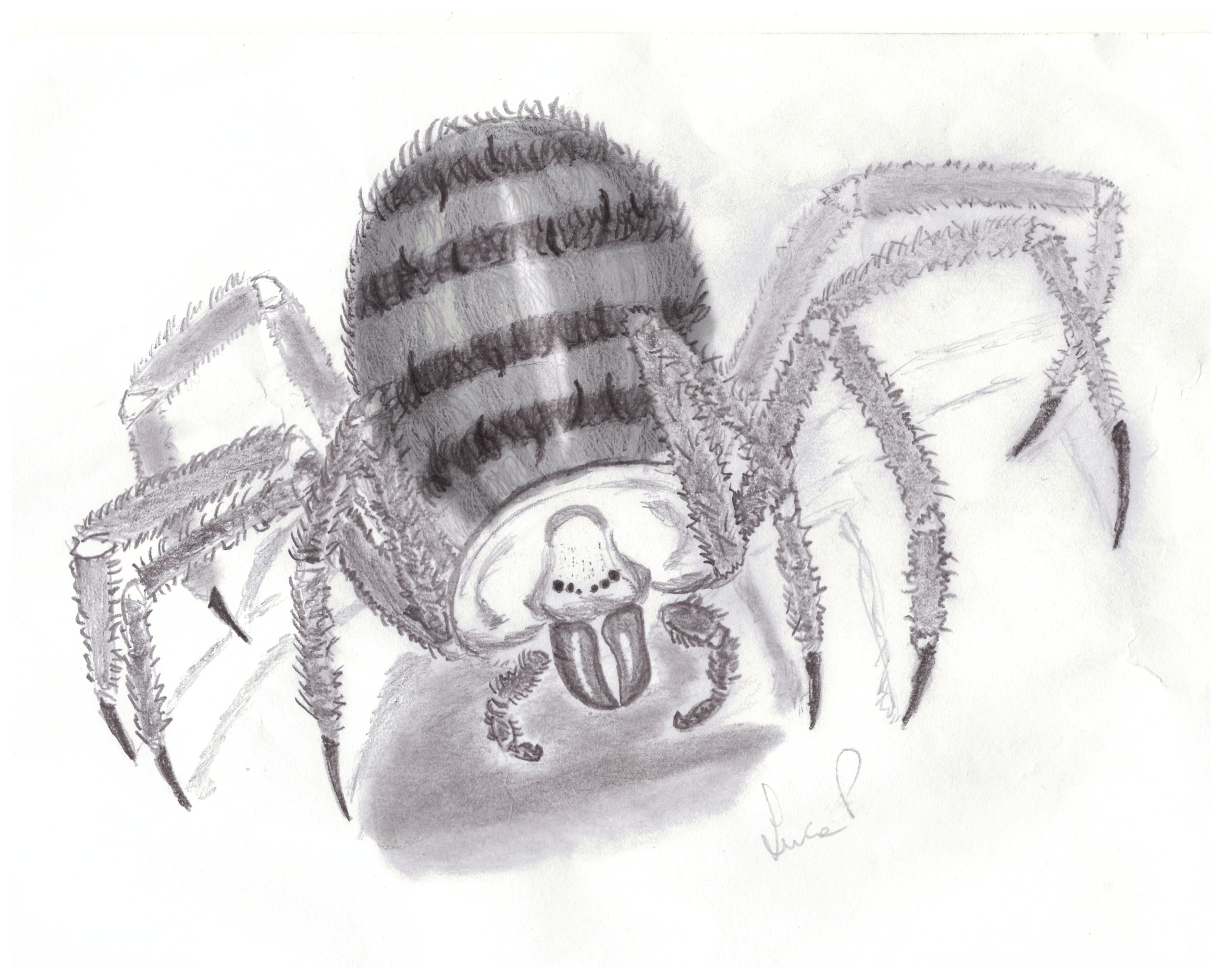Magpie Spider
In the karst recesses of the Syvaden forest explorers often find the dens of these massive spiders. The name derives from the black and white stripes on their abdomen.
In compare with other species of giant spiders, they are less territorial and aggressive but if left without escape route they will fight until death to defend their nest.
Physical description
Most individual of magpie spider are between sixty centimeters and two meters in diameter, although occasionally they can grow bigger. The cephalothorax and the legs are dark brown. The abdomen is striped alternating black to a very light brown, almost white. One of the most important features of these spiders is that they have three pairs of eyes, in line. The central pair are very close to the center of the cephalothorax, while the other eyes form a couple of each side granting these spiders an excellent range of vision. The abdomen, the legs and the palps are covered in a short fur that has tactile function. The legs' joints are of a lighter tone of brown. In this spiders the sexual dimorphism is not very marked.
Life-cycle
The life cycle of magpie spiders is usually limited to two or three years of adulthood, even if sometimes they can life longer. Each female during the spring produces several egg sacs over a period of three months and the males will fecundate them externally, each sac contains between forty and fifty eggs. The hatchlings grow to adult size in about eighteen months, in the first period of their life these spider are extremelly competitive for food and, for this reason, they often fight with the other hatchlings of the same brood. Once adult the magpie spider can resist very long time without water or food.
Behaviour
A magpie spider's stance on a flat surface is usually with all legs radially extended. When alarmed it may lower its body, withdraw the forward two legs straight rearward into a defensive position, withdraw the rearmost pair of legs into a position for lunging forward, and stand motionless with pedipalps raised. The pedipalps in mature specimens are dark and quite prominent and are normally held horizontally forward. When threatened it usually flees, seemingly to avoid a conflict, and if detained may further avoid contact with quick horizontal rotating movements or even resort to assuming a lifeless pose (playing dead). If force into a combat they will use the extremity of the all legs, that are provided with a spike, to try to render incapable the opponent while trying to bite with the chelicerae. Movement at virtually any speed is an evenly paced gait with legs extended. During travel, it stops naturally and periodically when renewing its internal hydraulic blood pressure that, like most spiders, requires to renew strength in its legs.
Habitat
Magpie spider create small irregular webs, that tends to have irregular shape. Most of these nest have an area that provide them shelter. Often they nest in abandoned caverns or grottos, favouring the ones that aren't too deep and the ones with more then one entry route, so that they can escape if needed. These spider often decorate and camouflage their nests using large pieces of bark and dead leaves. During the night they leave their nests to hunt, with the males that usually wander farther than the females. They bring their preys back to the nest where they produce a cocoon with their silk, seemingly, to let the meat season.
Magpie spiders in the popular culture
The shy nature of this giant spider has granted the diffusion of an 'old wives' tale', according to it the magpie spider, as per its name, collects and hoards shiny objects such as weapons, armors and pieces of jewelry. For such reason adventurers are often attracted by this spider's dens, in the hope to find something worth a pretty penny. The reality behind the tale is that the only equipment that you will find in a magpie spider's den is the one that a fallen adventurer carried with himself and, actually, the spider would prefer to avoid eating canned meat.
Let's raid the den of that huge magpie spider in the forest. What can go possibly wrong?
Toxin
Magpie spider's bite it's rarely lethal, the toxin injected causes in most cases mild pain and lack of sensitivity. It is reknown that, in certain cases, can unfortunately cause necrosis of the skin, leading possibly to the need to amputate the part affected. Luckily, this spider prefers to escape if attacked.
Warning! The image in the spoiler may upset some people, open it only if you are not easily scared




Comments